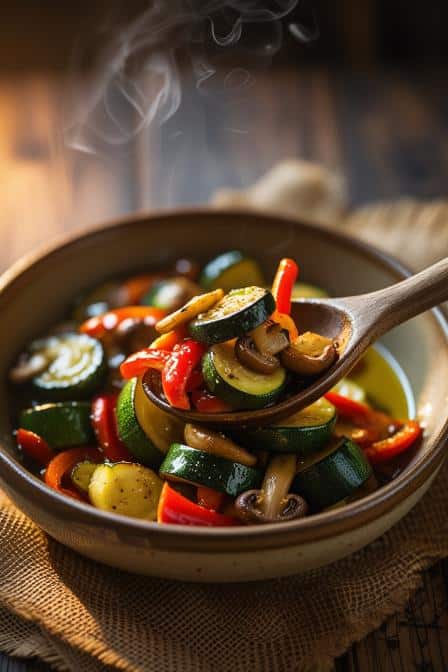When I was ten, I burned a pan of zucchini so badly my mother scraped it off the skillet like it was molten lava. She said, “You’re never cooking unsupervised again.” Thank heavens that didn’t stick. Now I burn fewer things—and sauté vegetables like a damned magician.
There’s a secret world tucked inside a hot pan, where carrots sizzle into sweetness and mushrooms turn meatier than steak. Sautéed vegetables are not just a side dish. They’re the ultimate blank canvas. Minimal ingredients, endless expression.
Professional cooks know this: mastering sautéing means understanding heat, timing, and texture. But also? It means not overcrowding the damn pan.
What Makes Sautéed Vegetables Special?
Sautéing is quick. It’s flavorful. It’s transformation at speed.
Unlike steaming or boiling, sautéing lets you brown and build layers of flavor. It wakes vegetables up. Gives them edge. Takes a humble squash and turns it into gold.
From stir-fried classics in Cantonese kitchens to the French mirepoix sweating under coq au vin—this technique crosses borders, cultures, and centuries.
Done right? Sautéed vegetables can taste more complex than a roast duck.
Ingredients & Substitutions
Here’s a core mix. But this ain’t gospel—switch, swap, improvise.
| Ingredient | Purpose/Flavor Note | Substitutions/Notes |
|---|---|---|
| Olive oil (extra virgin) | Fat + flavor carrier | Avocado oil, ghee, or sesame oil (for Asian tone) |
| Garlic (minced) | Sharp, aromatic base | Shallots, leeks, or garlic powder (if desperate) |
| Bell peppers (sliced) | Sweetness + color | Poblano for smokier, green beans for crunch |
| Carrots (julienned) | Earthy sweetness, firm bite | Parsnips or sweet potato (adjust cook time) |
| Zucchini (sliced) | Moisture + tender texture | Eggplant or yellow squash |
| Mushrooms (cremini) | Umami depth | Oyster, shiitake, or portobello |
| Red onion (sliced) | Sweet-savory balance | Yellow onion, shallot, or fennel |
| Salt | Essential seasoning | Sea salt, kosher salt |
| Black pepper | Mild heat + finish | White pepper, chili flakes |
| Fresh herbs (thyme/basil) | Bright final note | Dried versions (use sparingly) or parsley |
Ingredient Insights
Fresh garlic over powder. Always. It hits your nose like a freight train and adds real soul.
Use firm veggies that can handle high heat without going mushy. That’s why zucchini goes in late—not first.
Mushrooms? Don’t crowd ’em. They’ll steam instead of sear. Make them sing, not sob.
Step-by-Step Instructions
Let’s build it. Pan to plate. Minimal drama.
1. Heat the Pan
Use stainless steel or cast iron. Get it hot before adding oil. Not smoking, but just shy of it.
2. Add Oil
Drizzle in olive oil and let it shimmer. Tilt the pan so it coats the surface.
3. Start with Aromatics
In with the garlic. Maybe onion. Don’t walk away—it’ll burn in seconds.
4. Hard Veggies First
Carrots and bell peppers go in now. Let them char a bit. Stir, but not too often. Brown is good.
5. Add Softer Veggies
Zucchini and mushrooms next. They cook fast and release water. If the pan cools, crank the heat.
6. Seasoning Midway
Salt pulls out moisture. Add it now to let flavors bloom. Not all at the end.
7. Finish with Herbs
Fresh basil or thyme in the last 30 seconds. Off heat. They don’t like drama.
8. Serve Immediately
Hot, vibrant, glossy—like a vegetable runway.
Expert Tips
- Preheat your pan dry. Water should dance when flicked in.
- Don’t use wet veggies. Dry them with a towel or they’ll steam.
- Want browning? Let them sit in the pan. No constant stirring.
Common Mistakes
- Overcrowding. It’s the death of sautéing.
- Cold oil in cold pan. Just…no.
- Undersalting. Salt isn’t the enemy, blandness is.
Variations
- Add cumin and chili for a Tex-Mex vibe.
- Finish with soy sauce + sesame oil for Asian tone.
- Toss in cooked chickpeas or tofu for a meal-worthy dish.
Cooking Techniques & Science
Sautéing uses conduction—direct contact with hot surface. That quick heat causes the Maillard reaction. That’s your browning, your flavor jackpot.
Moisture is enemy no.1. Water lowers the temp and makes your pan sad. Dry veggies = better sear.
Using a wide pan gives steam somewhere to go. Narrow pans just trap it. That’s why your mushrooms go limp if they’re packed tight.
Tools That Matter
- Cast iron: retains heat. Great for browning.
- Stainless steel skillet: best surface for even heat.
- Wooden spoon or silicone spatula: gentle but firm.
- Mandoline or sharp knife: for consistent slicing.
Storage & Reheating
Store cooled sautéed veggies in an airtight container. Fridge for up to 4 days.
Reheat in skillet over medium heat. No microwave if you want texture. If dry, add a splash of broth.
Freeze? Eh. Not recommended. Texture gets weird.
Variations & Substitutions
- Vegan: default recipe is already vegan!
- Low sodium: use lemon juice to finish instead of salt.
- Spicy: red chili flakes, harissa, or diced jalapeños.
- Herbaceous: mint and dill are wild cards that work.
Serving & Pairing Suggestions
Pile on polenta. Spoon over rice. Serve next to roast chicken. Heck, stuff into a warm pita with hummus.
Want glam? Drizzle balsamic glaze or shave aged Parmesan on top.
Drinks? A dry Riesling, something with zip. Or sparkling water with lemon and mint for a clean vibe.
Color matters. Bright red peppers next to golden zucchini—it’s edible art.
Use a wide, shallow bowl for presentation. Don’t stack it like a hay bale.
Best Time to Serve This Dish
Midweek dinners. Lazy brunches. Post-yoga power bowls.
Sautéed veggies play well at room temp too. Picnic food? Hell yes.
They’re also fantastic for meal prep—just keep the reheating gentle.
Conclusion: Small Pan, Big Power
Sautéed vegetables aren’t a recipe. They’re a technique, a ritual, a test of restraint.
Let heat do its thing. Don’t rush it. Use your nose, your ears, your instincts.
Keep that pan hot, the veggies dry, and don’t panic. You’re not making soup.
Play with herbs. Vary your oils. Try ginger instead of garlic once in a while.
Master sautéed vegetables and you’ve basically unlocked the kitchen.
FAQs
1. Can I sauté frozen vegetables?
You can but expect steam, not sear. Thaw and pat dry first.
2. Why are my veggies soggy?
Likely too much moisture or an overcrowded pan. Spread them out. Crank the heat.
3. What’s the best oil for sautéing?
Depends on the flavor. Olive oil is classic. Use avocado or grapeseed for higher smoke points.
4. How do I stop garlic from burning?
Lower heat, or add it a little later. Burnt garlic is bitter and sad.
5. Can I use a nonstick pan?
Yes, but it won’t brown as well. Go stainless or cast iron for best results.

